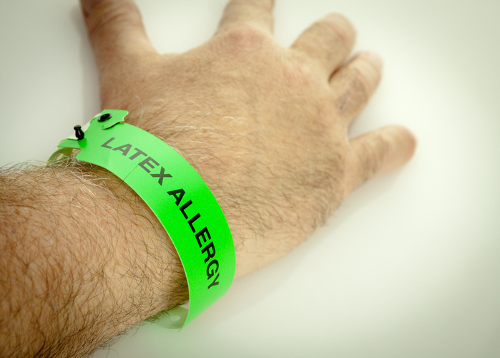 Allergies are fairly commonplace and many of us have them. For some of us, an allergy never really gets much thought. We’re allergic to an item that we don’t run into that often or something that’s easily avoided. Unfortunately, some people’s allergies aren’t easily avoided, especially when the substance is in many everyday items. People who are allergic to latex fall into that group. A latex allergy is when your body produces an allergic reaction to latex, a product made from the milky fluid taken from rubber trees.
Allergies are fairly commonplace and many of us have them. For some of us, an allergy never really gets much thought. We’re allergic to an item that we don’t run into that often or something that’s easily avoided. Unfortunately, some people’s allergies aren’t easily avoided, especially when the substance is in many everyday items. People who are allergic to latex fall into that group. A latex allergy is when your body produces an allergic reaction to latex, a product made from the milky fluid taken from rubber trees.
Latex is in tons of items—everything from rubber gloves to baby bottle nipples to catheters. It’s in condoms, elastic, spandex, and it can even be used to seal up the hole in your tooth from a root canal. With all the products that contain latex, is there anything that can be done about a latex allergy? What are latex allergy symptoms? Is there latex allergy treatment? In this article, we’ll explore what is latex allergy, the signs of a latex allergy, and how to treat a latex allergy and its various symptoms.
Latex Allergy Symptoms
A latex allergy is like many allergies in that it can have many symptoms and reactions. These symptoms can run from the slightly annoying (itchy skin) to the horrible (eyes swelling shut and shortness of breath). To this end, we’ve put together a list of the common symptoms of a latex allergy.
1. Itchy skin
The most common and mild of all the latex allergy symptoms is itchy skin, usually at the point of contact between the skin and latex.
2. Skin blemishes
The other most common of the symptoms of a latex allergy is skin blemishes. Things like skin redness, hives, and rashes. They usually appear at the point of skin contact but may spread depending on the severity of the allergy.
3. Sneezing, coughing, wheezing
Some of the more severe symptoms of a latex allergy are almost cold-like. The coughing, wheezing, and sneezing may begin very quickly after contact with the latex. These could be joined by other similar symptoms, like a runny nose and watery, itchy eyes.
4. Anaphylactic shock
The most severe of the symptoms to a latex allergy are the ones that are a part of anaphylactic shock. These may include difficulty breathing, rapid or weak pulse, difficulties breathing, and even loss of consciousness.
If you think you may have a latex allergy and find that you match with some of these symptoms, do not test yourself. Alert your doctor to the issues and have a proper allergy test. These symptoms can worsen or become more sensitive with more exposure.
What Causes a Latex Allergy?
If you have an allergy of any kind, including latex, you’ve probably asked yourself on several occasions, “What causes this allergy?” In terms of latex, the answer is both simple and complicated. Essentially, a latex allergy is caused by you having contact with latex and your body’s immune system becomes hypersensitive to it.
When your body comes in contact with latex, it releases a flood of chemicals like histamine in order to combat what the body sees as an enemy. In terms of the latex itself, you may only be allergic to one of its components. Most often it’s the proteins that make up latex that causes the allergic reaction but it may be one of the compounds that were used in the production of the latex.
Which now brings up the question, is there anything you can do to prevent a latex allergy?
Latex Allergy: Prevention and Treatment
Is there anything you can do to prevent a latex allergy? The truth is, no. Unfortunately, there seems to be little in the way of stopping a latex allergy from forming if you are going to have a latex allergy. That being said, if you have a latex allergy, there are ways to prevent a reaction from latex.
The simplest way may also be the hardest—avoid products with latex in them. If you don’t have contact with latex, you can’t have a reaction to it. However, latex is in a lot of things. Here’s a partial list of items you would want to avoid:
 Dishwashing gloves
Dishwashing gloves- Blood pressure cuffs
- Surgical masks
- Clothing waistbands
- Balloons
- Electrode pads
- Hot water bottles
- Baby bottle nipples
- Some disposable diapers
- Rubber bands
- Erasers
- Respirators
- Dental dams
- Diaphragms
- Racket handles
- Rubber toys
- Stethoscopes
- Intravenous tubing
- Condoms
- Swim goggles
As you can see, even the partial list is fairly long. So, if there are these many items with latex, what are the best options for treatment when you have an allergic reaction to latex? For mild reactions, it may be as simple as just waiting it out. A few days and the symptoms may subside.
For something a little more severe—in cases of skin blemishes, rashes, etc.—a steroid topical cream may be used. Your doctor may also prescribe an antihistamine to help bring everything back under control. For a severe reaction, your best bet is to go to the hospital. Make sure you let the hospital know that you are allergic to latex as many medical instruments use it. If your allergy is bad enough to warrant it, shots of epinephrine may be used, and you may get prescribed an epinephrine pen for emergency use.
Latex Allergies Are Serious
Latex allergies are nothing to be trifled with, even the mild allergies. The material is in so many products that it is hard to avoid. Something as simple as going to the hospital or the doctor may become a bit of an undertaking due to all the latex that you can find in a medical situation.
The best way to deal with it is to know your allergy and be prepared for it. That may mean only shopping at certain stores, or it may mean you keep an EpiPen on you at all times. Above all else, if you think you have an allergy to latex, talk to your doctor about it so proper tests can be conducted. This way, you can educate yourself properly on the ins and outs of having a latex allergy.
Related:
- Shellfish Allergy: Causes, Symptoms, and Treatment
- Tomato Allergy: Symptoms and Treatments
- Acupuncture: An Effective Alternative Allergy Treatment
- Have a Milk Allergy? Switching to Organic May Be Your Answer
Sources:
“Latex allergy,” Mayo Clinic; http://www.mayoclinic.org/diseases-conditions/latex-allergy/basics/definition/con-20024233, last accessed March 3, 2017.
“Latex Allergy: Common Items,” American Latex Allergy Association; http://latexallergyresources.org/common-latex-products, last accessed March 3, 2017.
“Latex Allergy: Symptoms,” American Latex Allergy Association; http://latexallergyresources.org/symptoms, last accessed March 3, 2017.
“Latex Allergy,” American Academy of Allergy, Asthma & Immunology; http://www.aaaai.org/conditions-and-treatments/allergies/latex-allergy, last accessed March 3, 2017.
“Latex Allergy,” Health Hype; http://www.healthhype.com/latex-allergy.html, last accessed March 3, 2017.
